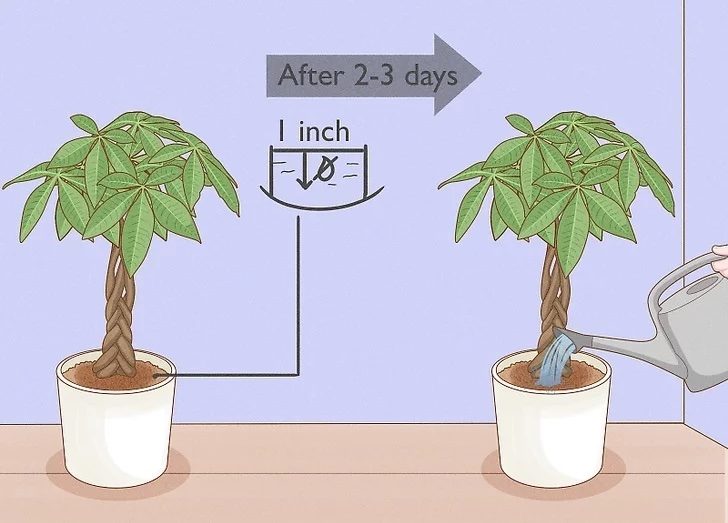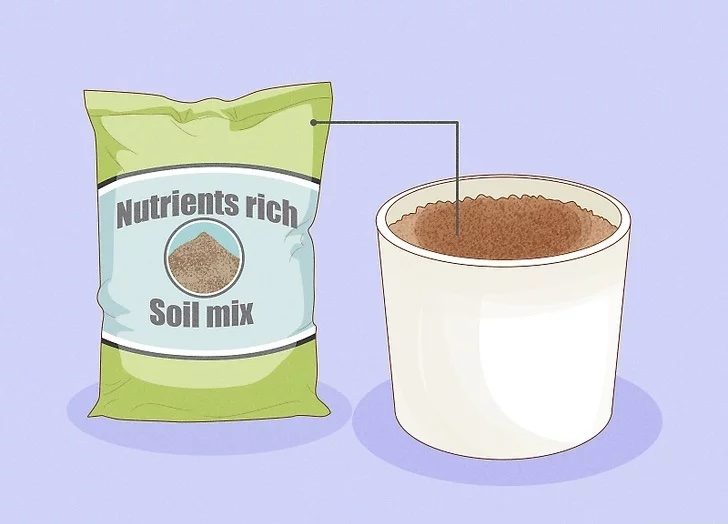- No products in the cart.
If you’re an experienced plant enthusiast or a beginner looking to add some greenery to your home, the money tree plant is a fantastic choice. With its reputation as a symbol of good fortune and its low-maintenance nature, it’s no wonder why this charming plant is so popular. This article will provide a comprehensive guide for money tree plant care and grow, covering everything from general maintenance to common illnesses.
Important Tips to Keep in Mind for Money Tree Plant Care:
- Choose a spot for your money tree that receives bright, indirect sunlight.
- Maintain a humid environment and keep the plant in a location where the temperature stays between 65-80°F (18-27°C).
- Water your money tree when the soil dries out, typically once every 1-2 weeks.
- If the leaves of your money tree start to turn yellow, water it less often or move it to a shadier spot.
Light & Temperature

1. To ensure the health of your money tree, it is important to place it in an area with bright, indirect light. Avoid exposing the plant to direct sunlight all day, especially if the windows in your home receive intense sunlight. Direct sunlight can cause the leaves of your money tree to become scorched.
- If your money tree is receiving too much light, you will notice that its leaves turn yellow and become dry.
- A suitable spot for your money tree plant could be a stand in your living room or on the top of your dresser in your bedroom. Just make sure that the plant won’t receive excessive direct sunlight in those areas.
- Rotate your money tree plant 30 to 90 degrees each time you water it. This will help distribute the sunlight evenly and prevent any one side of the plant from receiving too much or too little light.

2. Keep your money tree in a location with a temperature range of 65–80 °F (18–27 °C) to ensure its health. Extreme temperatures can adversely affect money trees, so avoid placing them near air conditioning vents or radiators. Additionally, avoid exposing the plant to drafts as much as possible. While the money tree can tolerate minor temperature fluctuations, it’s best to maintain a stable environment for optimal growth.

3. Consider placing a humidifier near your money tree if you live in a dry climate or if the humidity levels in your home are low. Ideally, the area where your money tree is located should have a consistent humidity level of around 50%. You can also use an indoor humidity monitor to keep track of the humidity in the room where your money tree is located.
- Although money trees prefer a humidity level of around 50%, they can still survive in lower humidity levels of 25-30%. However, in such cases, you may need to water them more frequently and they may experience some leaf loss.
Water

1. Wait until the top 1 inch (2.5 cm) of soil is dry before adding more water. You can test the soil moisture level by sticking your finger into the soil. If it feels damp, hold off on watering for a few more days. Overwatering can cause root rot, so it’s better to err on the side of underwatering.

2. Make sure to pour enough water until it begins to flow out of the drainage holes. This ensures that the soil is thoroughly watered and that excess water can escape. It’s important to keep watering until you see the excess water draining out, as this ensures that your money tree gets the amount of water it needs to thrive.
- It’s easier to overwater a money tree than to underwater it. Money trees are resilient and can tolerate some dryness, so it’s better to err on the side of underwatering than overwatering.
- After watering your money tree, be sure to empty any excess water from the drainage tray under the pot. This will prevent the roots from being exposed to standing water, which can lead to root rot and other issues.

3. Water your money tree less often in winter. Money trees grow slower in winter due to less light and thus require less water. During this period, wait for an extra 2-3 days after the soil dries out before watering again. Resume regular watering once spring arrives.
- Money trees tend to grow slower during winter due to reduced light availability. Hence, it is recommended to water them less frequently during this season to avoid overwatering.
Pruning & Shaping

1. Remove any yellow or dead leaves from the plant by hand. To keep your money tree healthy, remove any yellow or brown leaves by pinching them at the base and pulling them off by hand. Trimming dead or damaged leaves at the base of the branch can also help your plant conserve resources.
- While it is true that you don’t necessarily have to trim off dead or damaged leaves from your money tree, doing so can help it look healthier and more vibrant. Keeping the tree’s leaves in good condition will also help it use its resources more efficiently and grow more robustly.

2. Prune your money tree with shears for shaping. Shaping your money tree with pruning shears can be a fun and rewarding task. To shape the tree, simply imagine the outline of the desired shape and use pruning shears to trim any growth outside of that boundary. Cut the growth right after the nearest leaf node to the boundary line.
- The node is where the leaf’s primary branch meets the central stem of the plant.
- You can deviate from the traditional round, conical shape of a money tree and shape it into a square or triangular form if you desire.

3. To maintain a bonsai look, trim your money tree during the spring season. To achieve a bonsai look for your money tree, prune it during the spring by cutting back excessive growth and the largest leaves using pruning shears. This will restrict its growth during the growing season and help maintain its size. However, if you want your money tree to grow larger, it’s best to avoid pruning.
- Leaving at least half of the smallest leaves on the plant is important so that it can still absorb sunlight.
Soil & Fertilizer

1. Use a sufficiently large pot for the size you want your money tree to grow to. Choose a pot that accommodates your desired size for the money tree. A 4-6 in (10-15 cm) pot works well for a smaller 12-18 in (30-46 cm) money tree, while a 12-18 in (30-46 cm) pot can allow for growth beyond 3-4 ft (0.91-1.22 m).
- The size of a money tree can range from as small as 8 inches (20 cm) to as big as 10-12 feet (3.0-3.7 m), depending on the size of the pot it’s planted in. In its natural habitat, the money tree can grow up to 60 feet (18 m) tall!

2. Make sure the pot has enough drainage holes. When selecting a pot for your money tree, make sure it has sufficient drainage holes at the bottom. These holes will allow excess water to drain out of the soil and prevent root rot, a common problem in money trees caused by overwatering. Check the bottom of the pot while shopping to ensure it has drainage holes; if not, choose a different pot.
- When root rot occurs, the leaves of the money tree will start to yellow and droop, and the base of the main branches will become brown and soft. This is a sign that the roots of the plant are rotting due to overwatering, and it can be fatal if not addressed promptly.

3. Use fast-draining potting soil for your money tree, which is typically sold at garden centers. Use premade or homemade potting mix with high nitrogen, phosphorus, and potassium content.
- Money trees are quite adaptable when it comes to soil types. As long as you don’t use a clay pot, your plant should be able to thrive in various soil types.
- When the roots of your money tree start growing out of the drainage holes at the bottom of the pot, it’s a sign that you need to repot it.

4. Fertilize your money tree every 3-4 months. Fertilize your money tree with a water-soluble liquid fertilizer 3-4 times a year during the spring and summer growth season. Apply a few pea-sized dollops into the topsoil.
- As long as the liquid fertilizer is not designed specifically for outdoor plants, any general liquid fertilizer can be used for your money tree.
- While there are some recommended NPK ratios for different stages of growth, people have found success using fertilizers with varying NPK ratios for money trees. Therefore, there is no single “best” option for fertilizing money trees, and it’s best to experiment with different fertilizers to see what works best for your plant.
Pests & Common Problems

1. If your money tree looks dry, increase the humidity around it. If your money tree’s leaves are dry and falling, it may indicate that the plant needs more humidity. Consider using a humidifier, and if you already do, try running it for longer periods or adding a second humidifier. Keep your money tree away from heat vents, which can dry out the air.

2. Reduce watering and move away from direct sunlight if leaves turn yellow. Money trees are good at indicating when they’re unhappy. Yellowing leaves may indicate overwatering or excessive light. Check the soil moisture level and adjust watering frequency accordingly. If the soil is dry, move the plant away from the light.
- If you want to reduce the amount of light exposure for your money tree, you can simply move it 2-3 feet (0.61-0.91 m) away from the nearest window.

3. Use neem oil to eliminate pests on your money tree plant. Money trees are not commonly affected by pests, but spider mites and gnats may sometimes damage the plant. To get rid of pests, spray your money tree with neem oil or insecticidal soap daily until the pests are eliminated.
- If your money tree is constantly plagued by pests, it’s possible that the pests are coming from other plants in your home. Money trees usually don’t have major pest issues on their own.
Read more about Money Tree Plant Care:
- 4 Simple Methods to Propagate Money Tree Like a Pro
- Unlock Your Money Tree Plant’s Prosperity with the Best Soil: Essential Tips
- Money Tree Leaves Turning Brown: Causes and Fixes
Bonus TIPS for Money Tree Plant Care:
- Money trees are commonly sold with braided trunks, but if you have a young money tree plant and want to braid the trunks yourself, gently twist the trunks together in a spiral and secure them at the top with a twist tie. The trunks will eventually fuse together to create the iconic braided look.
- The money tree goes by many names depending on the region, such as Malabar chestnut, French peanut, Guiana chestnut, provision tree, Saba nut, Monguba, Pumpo, or money plant.
I hope this article will be helpful to you in terms of money tree plant care. Check out our blog to learn more about bonsai growing experiences and various bonsai products.

